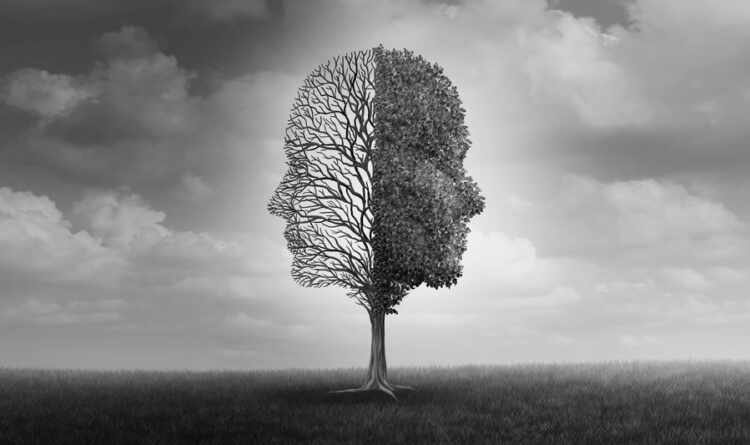A Client Named Tricia
Let’s pretend that you, dear reader, are a psychotherapist working with a 26-year-old female client named Tricia. Tricia’s been in treatment for about two months. When she first came to therapy, she was in a very low, depressive state. She wasn’t eating, slept constantly, and rarely showered. Not much has changed since then. She describes feeling hopeless, helpless, and empty. She’s attended sessions with you semi-regularly, but her depressive symptoms are not abating.
One day, Tricia comes to her session well-dressed and groomed with a full face of make-up, wearing tons of “wacky” jewelry, her hair freshly cut and dyed purple. During the session, she speaks rapidly, cracks jokes, makes terrible puns, and occasionally breaks out into song. It’s as though her tongue is struggling to keep up with her endless train of thoughts and witticisms. When you ask if she has used any substances, she assures you she has not. She can’t explain why, but over the past four days, Tricia has found herself full of motivation, creative ideas, optimism, and good cheer. She’s ready to “take the world by the tail,” several dozen projects at a time. In the past week, Tricia has signed up for a ballroom dance class, started writing a memoir, went on four dates with four different guys, painted her living room neon green, and started building a website for her new online bakery, in which her friends and family have financially invested. (Despite the fact that she’s never baked a cake or cookie in her life, she assures you it will be a success. Don’t ask how she knows. She just knows).
When you ask where she found the time to do all this, her response is, “I’ll sleep when I’m dead, friend!” When you tactfully question whether she will be able to keep up the momentum to complete these tasks, she dismisses your concerns, getting a bit irritated and distracted by her phone. You ask if she’s expecting to hear from someone, to which she responds with, “Well, I just don’t want them to hear me. You know, the FBI guys who are tapping my phone.” When you ask for an elaboration, she says that while she was sleeping the previous night, someone from the FBI tapped into her phone to discover all of her private messages. She cannot explain a motive or offer evidence that this happened (other than vague statements, such as, “When I woke up, my phone display was dimmer, so it must be the FBI sending me a message that they’re coming for me.”) She becomes irritated and evasive when you try questioning her about it further. Tricia ends up cutting the session short by twenty minutes, assuring you that you’ve “helped a ton!” and she “can’t wait for the next session!”
You do not see Tricia again for three weeks.
When Tricia finally returns to therapy, it’s as though the previous session never happened. Tricia is once again depressed, tearful, exhausted, describing feelings of emptiness and worthlessness. “It’s like I crashed and burned,” she says. She has abandoned all of her projects, uncompleted. She feels confused and guilty over the “fuss” she made, getting her friends and family invested in her “hair-brained projects.” She wishes she could just die. She wants you, her therapist, to explain what is wrong with her and how she can change.
So what’s your answer, counselor?
A Bipolar Overview: Mania, Hypomania, and Depression
Based on her symptoms, it is clear that Tricia is struggling with some form of Bipolar. Unlike unipolar mood disorders (such as Major Depressive Disorder or Dysthymia), the various forms of Bipolar involve drastic changes in mood, energy, thoughts, and behavior, represented by manic/hypomanic and depressive episodes (White & Preston, 2009). A 2005 study found that 2.6 percent of the U.S. population (over five million people) live with some form of Bipolar Disorder (“Could It Be Bipolar Disorder? 14 Signs to Look For,” 2020). Many with Bipolar Disorder experience long stretches of time in which neither depressive nor mania/hypomanic symptoms occur. However, when these episodes do occur, they cause dysfunction, distress, and sometimes danger to the afflicted person.
We All Have Occasional Mood Swings
Think of it as a series of peaks (mania/hypomania) and valleys (depression) with plateaus (baseline mood levels) in between. Every person’s emotional landscape is unique. We all have occasional mood swings. But the height of the mountains, the depth of the valleys, and the extent of the plateaus are factors determining whether someone has a disorder.
Mania/Hypomania
Let’s start with the peaks. Everyone has heard of mania and hypomania, but what exactly do these terms mean and what do they look like for someone living with Bipolar?
Both mania and hypomania consist of the same symptoms, involving abnormally elevated, expansive, or irritable moods and increased activity/energy (American Psychiatric Association, 2013). Often what distinguishes mania from hypomania is the severity and length of the symptoms, as well as whether psychosis is present (losing touch with reality—e.g., hallucinations, delusions, etc.—which is only applicable to mania) (American Psychiatric Association, 2013). With mania, mood changes last for at least one week condition, whereas with hypomania, they must last at least four consecutive days (American Psychiatric Association, 2013). In both cases, at least three of the following symptoms (four, if the mood is only irritable, as opposed to expansive/elevated) are present, representing a noticeable change from normal behavior:
- Inflated self-esteem or grandiosity
- Decreased need for sleep
- More talkativeness (a pressure to keep talking)
- Flights of ideas or racing thoughts
- Distractibility
- Increased goal-directed activities or physical agitation
- Excessive involvement in dangerous activities (American Psychiatric Association, 2013).
Manic/hypomanic episodes are observable by others, impair the individual’s normal functioning, and are not attributable to substance use or another medical condition (American Psychiatric Association, 2013). The conditions of mania are more severe than hypomania, often requiring hospitalization (“Bipolar Disorder,” 2017). Those diagnosed with Bipolar I must experience at least one manic episode, and often experience hypomanic episodes as well (American Psychiatric Association, 2013). Those with Bipolar II do not experience mania, but do experience at least one hypomanic episode over the course of their lives, often shifting between hypomania and depression (American Psychiatric Association, 2013).
Depression
Now to the valleys. Everyone experiences occasional bouts of sadness, but what differentiates these feelings from clinical depression? People struggling with Bipolar may experience major depressive episodes consisting of five or more of the following symptoms most of the time over a two-week period:
- Depressed mood (sadness, emptiness, hopelessness)
- Diminished interest or pleasure in nearly all activities
- Significant weight change (at least 5% of body weight change over a month)
- Sleep changes (insomnia or hypersomnia)
- Observable physical movement changes (agitation or retardation)
- Chronic fatigue
- Feelings of worthlessness or excessive guilt
- Difficulty concentrating or making decisions
- Recurrent thoughts of death or suicide (American Psychiatric Association, 2013).
These symptoms cause clinically significant distress or impairment and are not attributable to the effects of substance use or another medical condition (American Psychiatric Association, 2013).
Those struggling with Bipolar I will most likely experience major depressive episodes, but it is not required for the diagnosis (American Psychiatric Association, 2013). Those with Bipolar II must experience at least one major depressive episode (as well as at least one hypomanic episode) over the course of their lives (American Psychiatric Association, 2013).
What Is Cyclothymia?
Cyclothymic Disorder is a rarer, less severe form of Bipolar (“Cyclothymia (cyclothymic disorder),” 2018). This diagnosis is given to those who experience at least two years (for children, one year) of hypomanic and depressive periods without ever meeting the full criteria for mania, hypomania, or major depression (American Psychiatric Association, 2013).
If Bipolar I and Bipolar II consists of peaks and valleys, Cyclothymia consists of hills and dips. The “highs” do not meet the qualifications for mania or hypomania, but still represent a notable, elevated shift in mood and behavior. For example, one might become exceptionally energetic, creative, and productive, taking on more tasks and projects than usual, living on less sleep. When the depressive “dips” occur, the person experiences dysthymic symptoms, or a milder, more persistent form of depression. They might lose interest in task completion, sleep more, or derive little pleasure from previously enjoyable activities. Cyclothymia, though milder than Bipolar I and Bipolar II, is still a difficult, debilitating illness that often requires medical treatment.
It’s Likely that Tricia Suffers from Bipolar I
So back to Tricia! Based on her symptomology and the research presented here, it is likely that Tricia suffers from Bipolar I. The elevated symptoms presented during her last session (particularly her psychotic symptoms, as represented by delusions regarding the FBI tapping her phone) would likely qualify as a manic episode. When she is not in a manic state, she struggles with major depressive symptoms (not necessary for a Bipolar I diagnosis, but likely to occur for many). It should be noted that many clients with Bipolar, like Tricia, only come to therapy when they are experiencing depression. During manic/hypomanic episodes, they are less likely to realize that something is wrong with their moods and are more likely to stop taking their medications, thus increasing their risk of suicidality. The therapist would need to monitor Tricia moving forward to see if further episodes of mania or hypomania take place. If her symptoms become more severe (particularly with regard to suicidality during depressive episodes or psychosis during manic episodes), hospitalization may be necessary.
Any Form of Bipolar Should Receive Proper Medical Treatment
In summary, any form of Bipolar, whether it involves a full-blown manic episode (Bipolar I) or a dysthymic dip (Cyclothymia), creates dysfunction and distress for the person dealing with it and should receive proper medical treatment. Conventional treatment for Bipolar consists of medication management (such as mood stabilizers, anti-psychotics, or anti-depressants), psychotherapy (for example, cognitive interventions to help clients become more aware of and avoid triggers contributing to manic/hypomanic and depressive episodes, such as stress and irregular sleep patterns), and psychoeducation to help sufferers and their loved ones better understand the disease and why the mood shifts occur (“What Is Bipolar Disorder?,” 2021; White & Preston, 2009). With proper medical care and compassion, many struggling with Bipolar do find a means of managing their symptoms and live fulfilling, meaningful lives.
Courtesy: Gwendolyn Brown, M.S..
Resources:
- American Psychiatric Association. (2013). Diagnostic and statistical manual of mental disorders (5th ed.)
- “Bipolar Disorder” (2017). National Alliance on Mental Illness
- “Could It Be Bipolar Disorder? 14 Signs to Look For” (2020, February 13). Healthline
- “Cyclothymia (cyclothymic disorder)” (2018, May 10). Mayo Clinic
- “What Is Bipolar Disorder?” (2021). American Psychiatric Association
- White, R. C. & Preston, J. D. (2009). Bipolar 101. Oakland, CA: New Harbinger Publications, Inc.
Ready to find your therapist? Search the Jax Therapy Network and find the right therapist for you.






